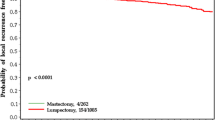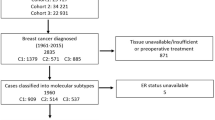Abstract
Purpose
To estimate the prognostic impact of estrogen receptor (ER)-status among women with primary invasive breast cancer, according to age at diagnosis.
Methods
We studied 1910 women with primary invasive breast cancer (stages I–III) who were treated at Women’s College Hospital between 1987 and 2000. For each patient, we obtained information on age at diagnosis, tumour size, lymph node status, ER-status, treatments received (radiotherapy, chemotherapy and tamoxifen) and dates and causes of death. Patients were followed from the date of diagnosis until the date of death from breast cancer or the date of last follow-up. We used the Kaplan–Meier method to estimate the 15-year actuarial rates of breast cancer-specific survival for women with ER-positive and ER-negative breast cancer, according to age at diagnosis (categories). We used the Cox proportional hazards model to estimate the adjusted hazard ratios for death from breast cancer associated with positive ER-status (compared to negative ER-status), stratified by age at diagnosis.
Results
We identified 1347 women with ER-positive breast cancer (70.5%) and 563 women with ER-negative breast cancer (29.5%). Among all 1910 women in the cohort, the actuarial rate of breast cancer-specific survival at 15 years was 77% for those with ER-positive breast cancer compared to 70% for those with ER-negative breast cancer (adjusted HR = 0.69; 95% CI 0.56–0.85; p = 0.0006). The prognostic impact of ER-status differed according to age at diagnosis. Among 213 women diagnosed before age 40, breast cancer-specific survival at 15 years was worse for those with ER-positive breast cancer than for those with ER-negative breast cancer (55 vs. 61%; adjusted HR = 0.90; 95% CI 0.57–1.41; p = 0.64). In contrast, among 1697 women diagnosed between ages 40 and 75, breast cancer-specific survival at 15 years was better for those with ER-positive breast cancer than for those with ER-negative breast cancer (78 vs. 72%; adjusted HR = 0.60; 95% CI 0.47–0.76; p < 0.0001).
Conclusions
Positive ER-status is a favourable prognostic factor among women diagnosed with breast cancer at or above age 40, but not among women diagnosed before age 40.







Similar content being viewed by others
References
Fredholm H, Magnusson K, Lindström LS et al (2016) Long-term outcome in young women with breast cancer: a population-based study. Breast Cancer Res Treat 160:131–143
Maggard MA, O’Connell JB, Lane KE et al (2003) Do young breast cancer patients have worse outcomes? J Surg Res 113:109–113
Chung M, Chang HR, Bland KI et al (1996) Younger women with breast carcinoma have a poorer prognosis than older women. Cancer 77:97–103
Nixon AJ, Neuberg D, Hayes DF, Gelman R, Connolly JK et al (1994) Relationship of patient age to pathologic features of the tumor and prognosis for patients with stage I or II breast cancer. J Clin Oncol 12:888–894
Bharat A, Aft RL, Gao F, Margenthaler JA (2009) Patient and tumor characteristics associated with increased mortality in young women (<or = 40 years) with breast cancer. J Surg Oncol 100:248–251
Fredholm H, Eaker S, Frisell J, Holmberg L, Fredriksson I, Lindman H (2009) Breast cancer in young women: poor survival despite intensive treatment. PLoS ONE 4:e7695
Narod SA (2012) Breast cancer in young women. Nat Rev Clin Oncol 9:460–470
Azim HA Jr, Michiels S, Bedard PL et al (2012) Elucidating prognosis and biology of breast cancer arising in young women using gene expression profiling. Clin Cancer Res 18:1341–1351
Paluch-Shimon S, Pagani O, Partridge AH et al (2016) Second international consensus guidelines for breast cancer in young women (BCY2). Breast 26:87–99
Parl FF, Schmidt BP, Dupont WD, Wagner RK (1984) Prognostic significance of estrogen receptor status in breast cancer in relation to tumor stage, axillary node metastasis, and histopathologic grading. Cancer 54:2237–2242
Crowe JP, Gordon NH, Hubay CA et al (1991) Estrogen receptor determination and long term survival of patients with carcinoma of the breast. Surg Gynecol Obstet 173:273–278
Jonasson JG, Stefansson OA, Johannsson OT et al (2016) Oestrogen receptor status, treatment and breast cancer prognosis in Icelandic BRCA2 mutation carriers. Br J Cancer 115:776–783
Aebi S, Gelber S, Castiglione-Gertsch M et al (2000) Is chemotherapy alone adequate for young women with oestrogen-receptor-positive breast cancer? Lancet 355:1869–1874
Ahn SH, Son BH, Kim SW et al (2007) Poor outcome of hormone receptor-positive breast cancer at very young age is due to tamoxifen resistance: nationwide survival data in Korea–a report from the Korean Breast Cancer Society. J Clin Oncol 25:2360–2368
Copson E, Eccles B, Maishman T et al (2013) Prospective observational study of breast cancer treatment outcomes for UK women aged 18–40 years at diagnosis: the POSH study. J Natl Cancer Inst 105:978–988
van der Hage JA, Mieog JS, van de Vijver MJ et al (2007) Efficacy of adjuvant chemotherapy according to hormone receptor status in young patients with breast cancer: a pooled analysis. Breast Cancer Res 9:R70
Yu KD, Wu J, Shen ZZ, Shao ZM (2012) Hazard of breast cancer-specific mortality among women with estrogen receptor-positive breast cancer after five years from diagnosis: implication for extended endocrine therapy. J Clin Endocrinol Metab 97:E2201–E2209
De Lima Vazquez F, Silva TB, Da Costa Vieira RA et al (2016) Retrospective analysis of breast cancer prognosis among young and older women in a Brazilian cohort of 738 patients, 1985–2002. Oncol Lett 12:4911–4924
Goldhirsch A, Gelber RD, Yothers G et al (2001) Adjuvant therapy for very young women with breast cancer: need for tailored treatments. J Natl Cancer Inst Monogr 30:44–51
Liu YR, Jiang YZ, Yu KD, Shao ZM (2015) Different patterns in the prognostic value of age for breast cancer-specific mortality depending on hormone receptor status: a SEER population-based analysis. Ann Surg Oncol 22:1102–1110
Wirapati P, Sotiriou C, Kunkel S et al (2008) Meta-analysis of gene expression profiles in breast cancer: toward a unified understanding of breast cancer subtyping and prognosis signatures. Breast Cancer Res 10:R65
Goldhirsch A, Winer EP, Coates AS et al (2013) Personalizing the treatment of women with early breast cancer: highlights of the St Gallen International Expert Consensus on the Primary Therapy of Early Breast Cancer 2013. Ann Oncol 24:2206–2223
Liedtke C, Rody A, Gluz O et al (2015) The prognostic impact of age in different molecular subtypes of breast cancer. Breast Cancer Res Treat 152:667–673
Johnson R, Hu P, Fan C, Anders CK (2015) Gene expression in “young adult type” breast cancer: a retrospective analysis. Oncotarget 6:13688–13702
Jenkins E, Deal A, Anders CK et al (2014) Age-specific changes in intrinsic breast cancer subtypes: a focus on older women. Oncologist 19:1076–1083
van de Vijver MJ, He YD, van’t Veer LJ et al (2002) A gene-expression signature as a predictor of survival in breast cancer. N Engl J Med 347:1999–2009
Buyse M, Loi S, van’t Veer L L et al (2006) Validation and clinical utility of a 70-gene prognostic signature for women with node-negative breast cancer. J Natl Cancer Inst 98:1183–1192
Paik S, Shak S, Tang G et al (2004) A multigene assay to predict recurrence of tamoxifen-treated, node-negative breast cancer. N Engl J Med 351:2817–2826
Wen H, Krystel-Whittemore M, Patil S et al (2017) Breast carcinoma with an Oncotype Dx recurrence score <18: rate of distant metastases in a large series with clinical follow-up. Cancer 123:131–137
Early Breast Cancer Trialists’ Collaborative Group (EBCTCG) (2005) Effects of chemotherapy and hormonal therapy for early breast cancer on recurrence and 15-year survival: an overview of the randomised trials. Lancet 365:1687–1717
Narod SA, Sopik V, Sun P (2017) Which women decide to take tamoxifen? Breast Cancer Res Treat. doi:10.1007/s10549-017-4226-4
Gorman JR, Usita PM, Madlensky L, Pierce JP (2011) Young breast cancer survivors: their perspectives on treatment decisions and fertility concerns. Cancer Nurs 34:32–40
Jacobson MH, Mertens AC, Spencer JB, Manatunga AK, Howards PP (2016) Menses resumption after cancer treatment-induced amenorrhea occurs early or not at all. Fertil Steril 105(765–72):e4
Eisen A, Fletcher GG, Gandhi S et al (2015) Optimal systemic therapy for early breast cancer in women: a clinical practice guideline. Curr Oncol 22:S67–S81
Olivotto IA, Bajdik CD, Ravdin PM et al (2005) Population-based validation of the prognostic model ADJUVANT! for early breast cancer. J Clin Oncol 23:2716–2725
Author information
Authors and Affiliations
Corresponding author
Ethics declarations
Conflicts of interest
The authors declare that they have no conflicts of interest.
Ethical approval
All procedures performed in studies involving human participants were in accordance with the ethical standards of the institutional and/or national research committee and with the 1964 Helsinki declaration and its later amendments or comparable ethical standards.
Informed consent
Informed consent was obtained from all individual participants included in the study.
Rights and permissions
About this article
Cite this article
Sopik, V., Sun, P. & Narod, S.A. The prognostic effect of estrogen receptor status differs for younger versus older breast cancer patients. Breast Cancer Res Treat 165, 391–402 (2017). https://doi.org/10.1007/s10549-017-4333-2
Received:
Accepted:
Published:
Issue Date:
DOI: https://doi.org/10.1007/s10549-017-4333-2




